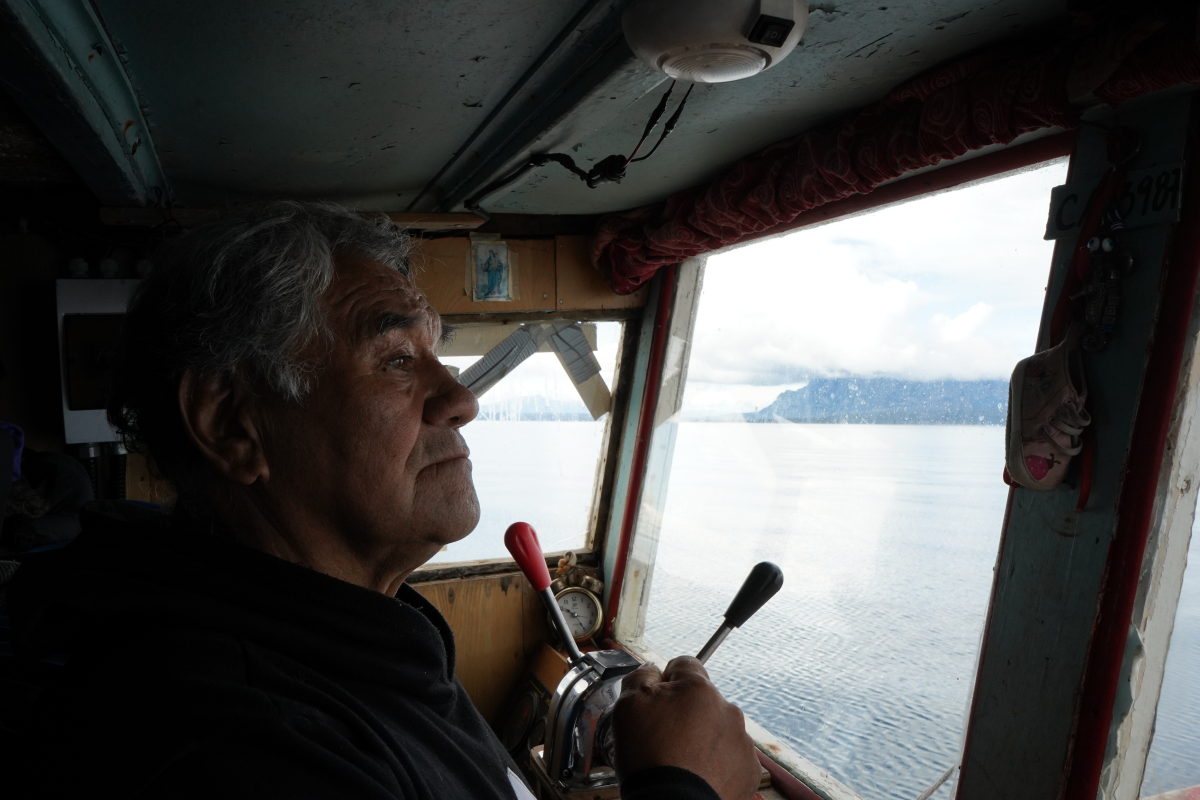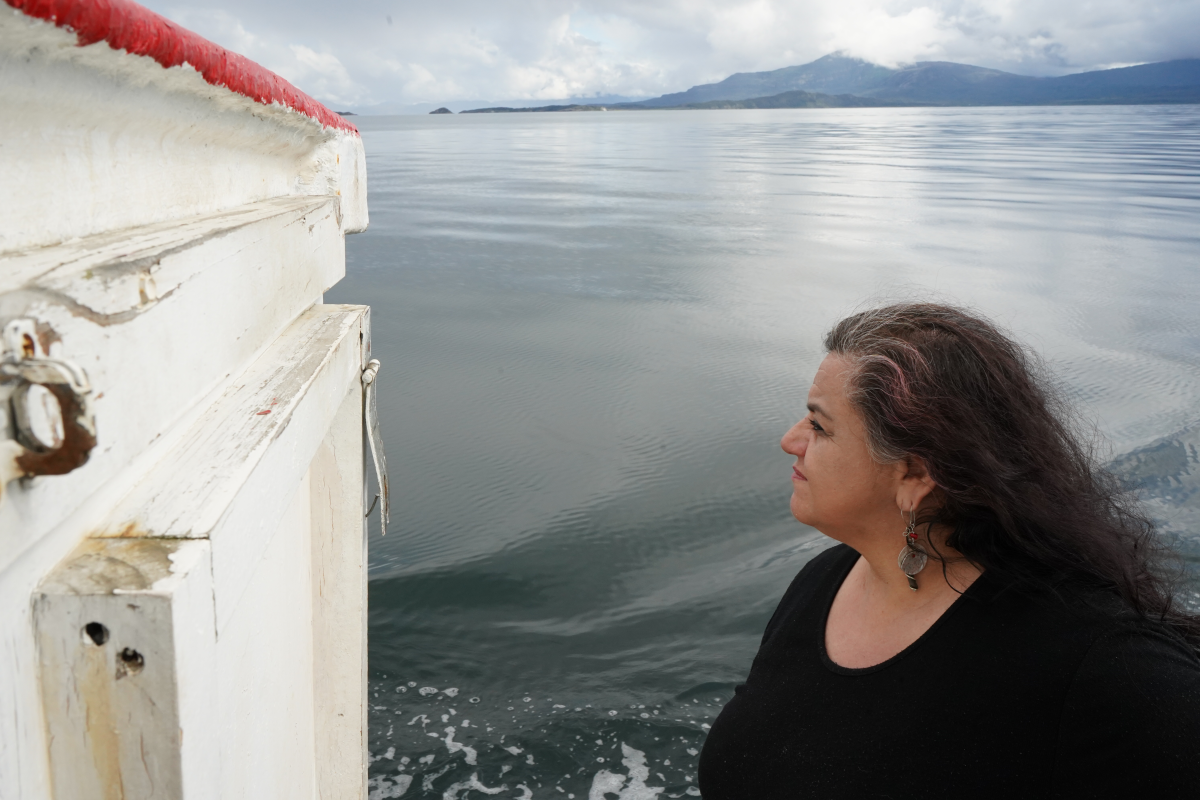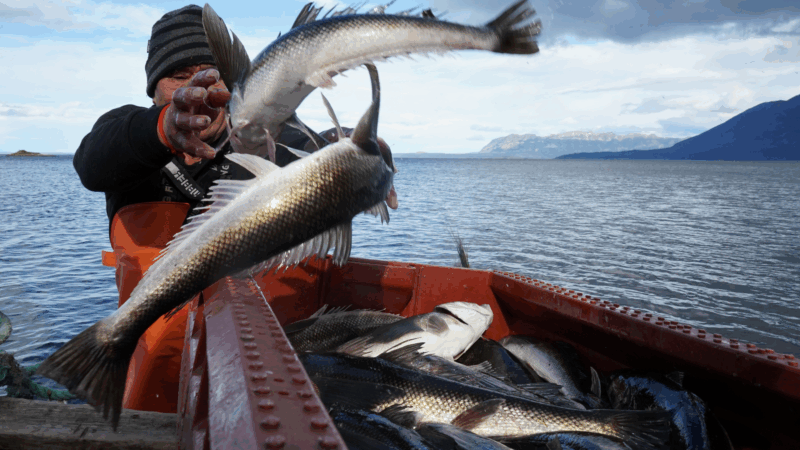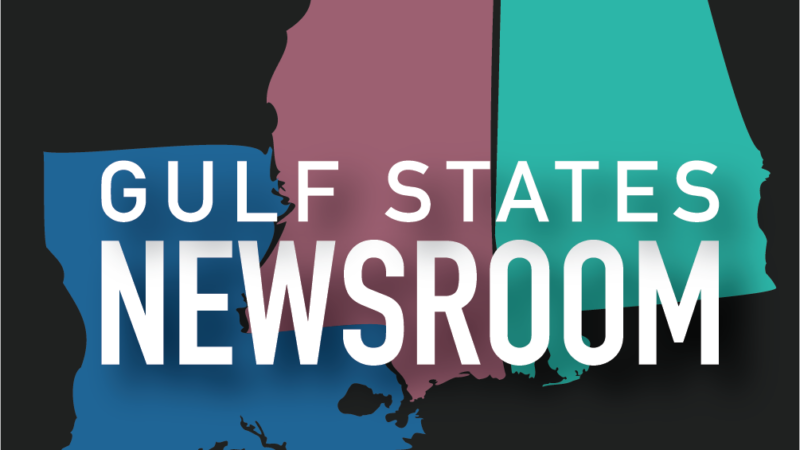Chile’s Indigenous fishermen say the salmon industry threatens their way of life
PUERTO NATALES, Chile — Out beyond Isla Focus, a bare island in the fjords an hour off the coast of Puerto Natales, southern Chile, the waves pick up and the Calipso rocks alarmingly from side to side.
Reinaldo Caro is the swarthy captain of the tiny fishing vessel, and he has spotted something amid the pristine Patagonian woodland high above the shoreline: a single, white-bark tree.
“There!” he exclaims suddenly, his thick eyebrows lifting as his face softens into a broad smile. “That’s where I was born.”
“And then that’s what I’m fighting against,” he says, tracing a path down the hillside with a finger, fixing it on a pontoon floating directly below his birthplace.
It belongs to one of the many salmon farms that dot the fjords, although from the surface, there isn’t much to see. A control room sits alongside several floating walkways.
The salmon farming industry operates along great swaths of Chile’s coastline, from the center of the country and down through Patagonia.
And Caro, 78, decries the effect it has had on his ancestral home.
He is one of the very last Kawésqar fishermen sailing these fjords, one of the seminomadic Indigenous peoples who navigated the channels for millennia in carved wooden canoes.
Today, there are fewer than 1,000 Kawésqar left.
“There are loads of these farms,” Caro says over the throb of the Calipso’s diesel engine.

With each pontoon that passes by, he reels off the name of the company which operates it and then the moniker he has for each tiny bay nearest to the farm.
In some, he says, Kawésqar would cut down the trees to make their canoes. In others, huddles of cormorants gather on the black sand beaches, and sea lions bark from the rocks.
“From up here it looks beautiful and pristine, like a mirror, but down there it’s a different story,” Caro explains. “The contamination is on the seabed — it comes from the feces and medication they give them.”
“Maybe 30 or 35 years ago, this place was totally pristine. Now we’re up to our necks in it,” he says bitterly.
In 2024, the United States, Japan and Brazil were the major markets for Chilean salmon, and more than half of the salmon available in U.S. supermarkets came from Chile.
After copper, the backbone of the Chilean economy accounting for more than half of the gross domestic product, salmon products are, albeit distantly, the country’s second-largest export.
Last year, $6.3 billion worth of salmon was sent abroad, according to the Chilean Salmon Council. One-quarter of the world’s salmon is farmed in Chile. Only Norway exports more.
Yet the fish are not native to these waters, and fishermen like Caro say that they are damaging Chilean ecosystems.
“I think it’s important to talk about how vulnerable these ecosystems are in general to change,” says marine biologist Claudio Carocca, who has written extensively about the effects of the salmon industry .
“In this case, the changes affected by human activity range from installing pontoons with their steel, plastic, ropes and lights; to the nonnative fish species introduced, and the chemicals and food injected to help them grow,” he says.
The Chilean Salmon Council, which represents the largest salmon farming companies in the country, declined NPR’s request for comment on the issues raised by the local community. The council’s website says salmon farming has the potential to provide “a healthy and sustainable source of protein” for growing global demand for quality foods. “We believe this can be achieved responsibly, caring for the environment and ensuring the highest environmental, social and animal welfare standards,” it says. The website also says the industry has worked to reduce the use antimicrobials.
Conditions in Chile are seen as ideal for salmon farming, with the first attempts to introduce salmon dating as far back as the 19th century.
In 1969, an agreement between Japan and Chile’s national fishing agency saw Pacific salmon formally introduced, bringing Dutch and Japanese companies into the country.
The national fishing service was then formed in 1976 under the dictatorship of Gen. Augusto Pinochet, and production skyrocketed from the mid-1980s.
A salmon usually reaches its commercial size and weight at 4 years old, but in a farm this is cut to 10 to 14 months.

Reinaldo Caro’s daughter, Leticia Caro, grew up sailing these fjords with her father, who has always worked at sea.
She was 6 years old when she came out fishing with her father for the first time, where she’d help clean the fish and disentangle the nets.
“I think that things can be done differently, because salmon farming will never be sustainable,” she says.
“If the industry hadn’t moved into our home, the Kawésqar would probably still be living on these shores the way we always did. It’s vital that after thousands of years in these channels, the balance is maintained.”
Chile’s salmon industry has long been criticized for polluting the fjords and coastline, triggering record algal blooms, regular escapes that threaten native wildlife, as well as a heavy use of antimicrobials.
Salmon farms pump more than 350 metric tons of antibiotics into the sea each year. Given these quantities, the nongovernmental watchdog group Seafood Watch recommends that people avoid eating Chilean salmon unless it’s purchased from a certified, sustainable business.
However, legislation is in its final stage on its passage through Chilean congress that would deem salmon farming and the Kawésqar people’s traditional way of life in the area “totally incompatible,” halting the expansion of the industry.
Politicians are also debating whether to freeze or limit concessions on new farms in the southernmost waters.

“They should go,” says Carocca. “But it’s not so simple — lots of people depend on the industry for work. What we need to ask ourselves is what is left when the farms move on? What will those people do?”
“Because we have already seen nearly 50 years of a model which doesn’t work, based on an exotic species which isn’t from here, and which requires so much to be added to the water for it to work.”
“It generates billions of dollars, but how many billions is all this destruction worth?”
Auburn tabs USF’s Alex Golesh as its next coach, replacing Hugh Freeze on the Plains
The 41-year-old Golesh, who was born in Russia and moved to the United State at age 7, is signing a six-year contract that averages more than $7 million annually to replace Hugh Freeze. Freeze was fired in early November after failing to fix Auburn’s offensive issues in three seasons on the Plains.
Alabama Power seeks to delay rate hike for new gas plant amid outcry
The state’s largest utility has proposed delaying the rate increase from its purchase of a $622 million natural gas plant until 2028.
Former U.S. Sen. Doug Jones announces run for Alabama governor
Jones announced his campaign Monday afternoon, hours after filing campaign paperwork with the Secretary of State's Office. His gubernatorial bid could set up a rematch with U.S. Sen. Tommy Tuberville, the Republican who defeated Jones in 2020 and is now running for governor.
Scorching Saturdays: The rising heat threat inside football stadiums
Excessive heat and more frequent medical incidents in Southern college football stadiums could be a warning sign for universities across the country.
The Gulf States Newsroom is hiring an Audio Editor
The Gulf States Newsroom is hiring an Audio Editor to join our award-winning team covering important regional stories across Mississippi, Alabama and Louisiana.
Judge orders new Alabama Senate map after ruling found racial gerrymandering
U.S. District Judge Anna Manasco, appointed by President Donald Trump during his first term, issued the ruling Monday putting a new court-selected map in place for the 2026 and 2030 elections.









